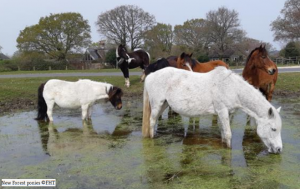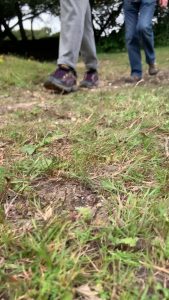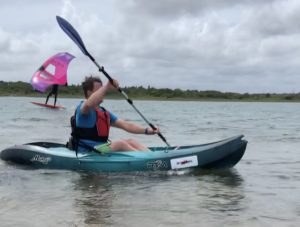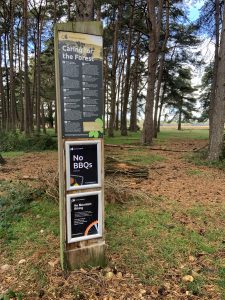Right activity, right place: enjoying and protecting the New Forest
7th February 2023
Through its Wilder for Water campaign, Freshwater Habitats Trust encourages people to enjoy activities in the New Forest without damaging its internationally significant wildlife habitats.
The New Forest is home to a unique mosaic of freshwater habitats. Together, these ponds, streams, rivers, mires and wetlands support more than two-thirds of all the UK’s freshwater species and more than a third of the UK’s rarest plants and invertebrates.
 Natural processes and human activities have modified and reshaped this landscape for thousands of years. Despite this, the New Forest includes large areas of pristine freshwater habitats, supported by clean water and free from pollution. The New Forest National Park also has the highest proportion of designated land for nature conservation than any other in the country.
Natural processes and human activities have modified and reshaped this landscape for thousands of years. Despite this, the New Forest includes large areas of pristine freshwater habitats, supported by clean water and free from pollution. The New Forest National Park also has the highest proportion of designated land for nature conservation than any other in the country.
The New Forest is one of the most visited National Parks in the country. We can enjoy spending time in the Forest without upsetting this delicate balance of nature.
Here we share some tips on how you can get the most out of your time in the New Forest, while minimising any negative impacts on habitats and wildlife.
Walking in the New Forest
 Walking is a wonderful way to experience the peace and natural beauty of the New Forest. But there are some impacts that are associated with it, including the disturbance of wildlife.
Walking is a wonderful way to experience the peace and natural beauty of the New Forest. But there are some impacts that are associated with it, including the disturbance of wildlife.
A particularly sensitive time of year for wildlife is the bird breeding season between 1 March and 31 July. The New Forest has internationally important populations of ground nesting birds that reside in habitats such as heathlands and shingle beaches. Keep an eye out for signs posted by Forestry England and other organisations to alert visitors to areas that are important for these birds. The advice is to avoid these areas or keep to the main tracks. Dogs are to be kept to the tracks too and if necessary, on a lead.
The National Park Authority have provided great walking routes, but always ensure you adhere to signs when accessing the Forest.
By sticking to the tracks, you can control other impacts, such as reducing damage to the wetland soils and preventing the spread of invasive non-native species.
Cycling the Forest trails
There are more than 100 miles of waymarked cycle routes in the New Forest. Most are on permitted gravel tracks and quiet roads. There are many places in and around the New Forest to hire bikes and Pedall makes cycling accessible to all by offering adapted bikes and guided sessions.
Using a bike off a permitted cycle route in the New Forest can affect sensitive wetland habitats. Excessive erosion, spread of invasive non-native species and disturbance to plant and wildlife communities can even lead to the loss of rare species.
For those looking for more adventurous mountain biking, there are purpose-built trails at places such as Moors Valley Country Park and further afield Queen Elizabeth Country Park. These Parks are better designed for mountain biking, and day-long visits. Both country parks include plenty of parking, toilets, wild play spaces, dog poo bins and cycle hire.
Swimming in the New Forest
Wild swimming is generally not permitted across the National Park due to the conservation status of the flowing and standing waterbodies. However, there are coastal bathing waters, which are designated for swimming. The Government website will locate your nearest place for a sea swim and give an indication of the water quality.
Many waterbodies in the New Forest are designated to protect wildlife, which is sensitive to the disturbance from people and pets. Cleaning products and other chemicals, contained in our clothing or our dog’s fur, can leach into the water. This can change the water quality for the worse, impacting on the plants and wildlife that live there.
There is lots to consider with an activity like open water swimming to keep yourself safe. The best way to learn about wild swimming places is through community groups such as The Bluetit chill swimmers. Local knowledge not only helps you swim in safe places but also lessens the likelihood you will be within a protected area where swimming is not allowed.
There are other opportunities in and around the New Forest to access water if sea swimming isn’t your thing. Lymington Salt Water Baths and New Forest Water Park are great places to experience swimming in open water, with facilities close by.
Paddle sports
 There are many launch sites and resources available to those wishing to kayak, canoe or paddle board. Paddle sports are a great way to see the coastline but can present problems with disturbance to wildlife. The New Forest coastline is internationally designated for its coastal habitats and wildlife particularly wading and over wintering birds.
There are many launch sites and resources available to those wishing to kayak, canoe or paddle board. Paddle sports are a great way to see the coastline but can present problems with disturbance to wildlife. The New Forest coastline is internationally designated for its coastal habitats and wildlife particularly wading and over wintering birds.
There is now a bespoke map, produced by Bird Aware Solent, which has excellent advice including launch sites and routes which limit disturbances to wildlife.
Guided sessions are an excellent way to start or if unsure about places to paddle. Many activity centres offer tours. New Forest activities offer tours on the Beaulieu River and New Forest Paddle Sport Company offers paddleboarding to Hurst Castle. Following local knowledge and advice will help you to undertake fun activities in a responsible way for your safety and the environment. If you are unsure about a location, it is best not to paddle there.
The New Forest is a No BBQ and fire zone as this type of environment is at high risk to wildfires, especially during hot dry weather. BBQs, including disposable ones, campfires or fires of any kind are not permitted in car parks or other areas of the Forest. Some campsites and country parks do allow BBQs or fires under specific conditions so please check beforehand.
Remember: Check, Clean, Dry
As visitors to the Forest, it’s essential that we all follow the national Check Clean Dry message. Invasive non native species can cause irreversible damage to the natural environment, on land and in our waterways. Before visiting the Forest ensure all equipment and footwear has been cleaned. To find out more read our recent blog.
There are many ways to enjoy the New Forest. Our advice is to plan and prepare, whether visiting for the day or on holiday. There is a wealth of information out there to ensure your visit is environmentally friendly, and you can be safe in the knowledge habitats and wildlife are protected.
Freshwater Habitats Trust is dedicated to protecting the internationally important wetlands of the New Forest. With our Water Code, visitors can learn how to become water and wildlife friendly by ensuring their actions are safeguarding clean water for wildlife, and space for nature.
In partnership with the New Forest National Park Authority and funded by the Green Recovery Challenge Fund and Environment Agency, Our project, Wilder for Water, works with visitors, organisations and businesses to raise awareness of the special qualities of the New Forest waterscape. As co-hosts of the New Forest catchment, we’re promoting a best practice ‘clean water standard’ for camping and recreation across the National Park and beyond.

